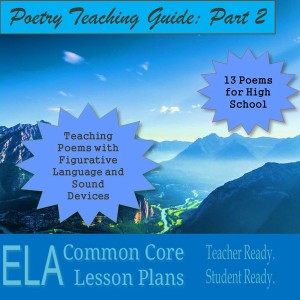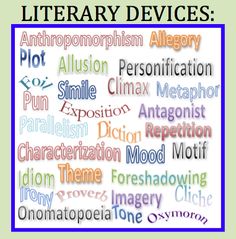Literary Terms Lesson Plan
The good ol’ days of define these literary terms and there’s a quiz on Friday are over. This teaching to different learning styles lesson plan allows you to cover a lot of information in a short amount of time.
Here’s a quick short story map that reinforces basic literary elements (plot, conflict, setting, and characterization). It’s a bonus. The lesson plan below is even better.
Speaking of “The Good Ol’ Days”

Remember these literary terms lesson plan procedures? Perhaps you've tried them in your own class?
- Copy down these 20 terms.
- Look them up in the glossary.
- Write the definition.
- Study them.
- Take the quiz on Friday.
Here's what actually happens:
- Student copies down 20 terms.
- Student looks 3 or 4 up in the glossary and borrows his friend's paper for the rest.
- Student copies definitions.
- Student crumples up paper, shoves it in her backpack, pulls it out 2 minutes before the quiz.
- After the quiz, student crumples up paper, throws it in the trash, never to be seen again.
- Student forgets literary terms.
- You get angry and determine it's time for new literary terms lesson plans, ones that involve teaching to different learning styles.
Teaching Literary Terms to Different Learning Styles Lesson Plan Procedures
-
Teach literary terms with visual aides designed by students.
Write literary terms on the board. You will need one for each student. Yes, there are enough literary terms: plot, setting, exposition, mood, theme, tone, character, conflict, 5 types of conflict, point of view, three types of point of view, dramatic, verbal, and situational irony, suspense, foreshadowing, alliteration, synecdoche, personification, metaphor, simile, onomatopoeia, hyperbole, meiosis, rhythm, meter, voice, style.....
- Pronounce each term and have students repeat it.
- Assign one term to each student.
- On a clear slice of paper, each student will design a poster. The poster will have the term at the top with its definition below. The middle of the paper will have a visual representation--picture or symbol--that represents the term along with a written example from a piece of literature familiar to the class.
- Instruct students to extract a slice of notebook paper and copy the terms. Leave enough room to take notes next to each word.
- Everything should be removed from desks except the literary term poster, the notes paper, and a writing instrument.
- Every 45 seconds, shout pass. Students will pass their paper to the next designated person. Each student will have 45 seconds to study each literary terms poster. Once the term has made it around the room, stop.
- Instruct students to make any corrections on any poster.
- Do the activity in part one of this series.
- Give a quiz the next day and boast how great you are at teaching to different learning styles and how you deserve a raise and a vacation in the Dominican Republic!
ELA Common Core Standards Covered
Amaze your administrator by teaching literary terms to different learning styles. Here are some ELA Common Core Standards to cement your raise.
- RL.9-10.1 Cite strong and thorough textual evidence to support analysis of what the text says explicitly as well as inferences drawn from the text.
- RL.9-10.2 Determine a theme or central idea of a text and analyze in detail its development over the course of the text, including how it emerges and is shaped and refined by specific details; provide an objective summary of the text.
- RL.9-10.10 By the end of grade 9, read and comprehend literature, including stories, dramas, and poems, in the grades 9-10 text complexity band proficiently, with scaffolding as needed at the high end of the range. By the end of grade 10, read and comprehend literature, including stories, dramas, and poems, at the high end of the grades 9-10 text complexity band independently and proficiently.
- Common Core Writing Standard 1. Write arguments to support claims in an analysis of substantive topics or texts, using valid reasoning and relevant and sufficient evidence.
- Common Core Writing Standard 2. Write informative/explanatory texts to examine and convey complex ideas, concepts, and information clearly and accurately through the effective selection, organization, and analysis of content.
Teaching Literary Elements with Short Stories
Understanding literary elements is necessary for literary analysis. These short stories will help you teach literary elements.
- The Best American Short Stories
- Short Stories for Teaching Theme
- Short Stories for Teaching Irony
- Short Stories for Teaching Symbolism
- Short Stories for Teaching Conflict
- Short Stories for Teaching Foreshadowing
- Short Stories for Teaching Imagery
- Short Stories for Teaching Characterization
Last Updated on December 6, 2016 by Trenton Lorcher
Share This:
